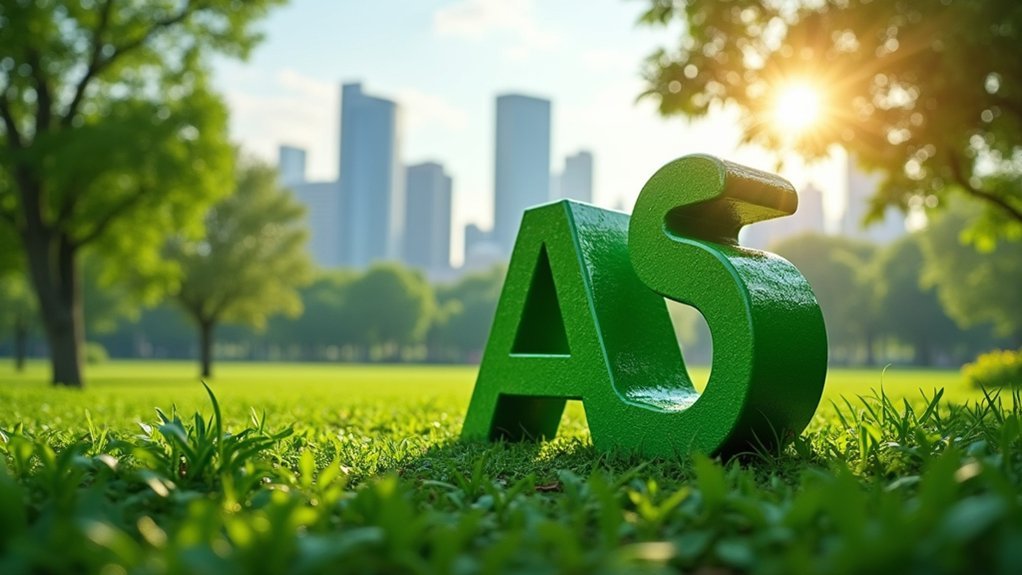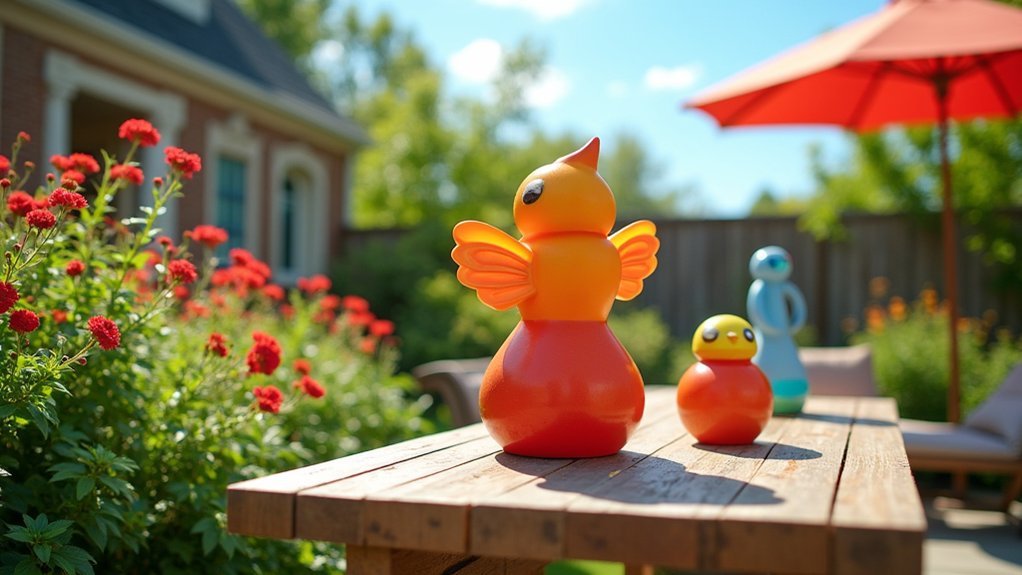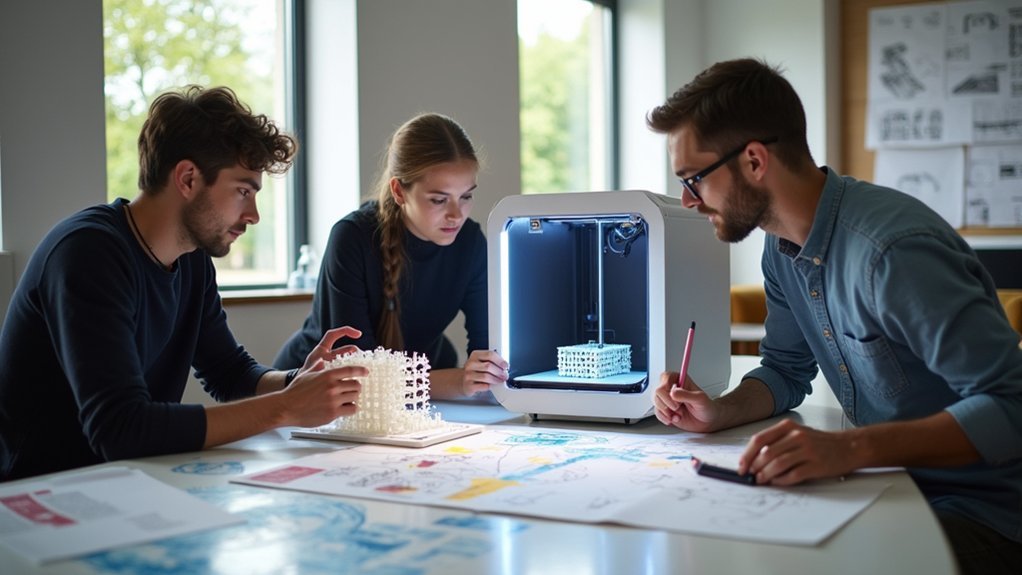You’ll want ASA filament for outdoor printing because it offers ten times more UV resistance than ABS, preventing color fading and cracking from sun exposure. It maintains dimensional stability in extreme temperatures up to 100°C, resists moisture and chemicals like oils and acids, and provides exceptional impact strength of 30 kJ/m². ASA’s anti-static properties also protect electronic components while ensuring your prints retain professional appearance and structural integrity through harsh weather conditions and environmental challenges ahead.
Exceptional UV Resistance and Weather Protection

When you’re selecting filament for outdoor 3D printing projects, ASA stands out as the premier choice due to its exceptional UV resistance that far surpasses common alternatives like ABS and PETG.
You’ll find that ASA is ten times more UV-resistant than ABS, preventing color fading and breakage when exposed to direct sunlight.
This material’s weather protection benefits extend beyond UV resistance—it’s moisture-resistant, chemically resistant, and maintains dimensional stability under extreme temperatures.
You won’t experience warping or shrinkage that compromises your prints.
ASA’s high impact durability guarantees your outdoor parts withstand environmental factors and physical stress. The material also provides excellent anti-static properties that help protect sensitive electronic components in outdoor applications.
Whether you’re creating outdoor signage, protective guards, or industrial equipment covers, ASA delivers long-term performance without degradation.
Superior Mechanical Strength for Harsh Conditions
Beyond its impressive weather resistance capabilities, ASA filament delivers superior mechanical strength that makes it exceptionally well-suited for harsh outdoor conditions.
You’ll appreciate its high impact strength of approximately 30 kJ/m², ensuring your prints resist sudden shocks and drops without cracking. ASA’s excellent rigidity maintains structural integrity under load, making it perfect for mounting brackets and housings that won’t bend or deform.
The material’s moisture resistance prevents weakening in humid conditions while maintaining dimensional accuracy. ASA retains its shape at temperatures up to 100°C, making it reliable for applications exposed to heat and thermal cycling.
You’ll find ASA withstands repeated stress cycles without performance loss, ideal for applications with moving components or vibration exposure.
Additionally, you can enhance mechanical properties through acetone polishing, which smooths surfaces and seals micro-cracks for improved durability in demanding outdoor environments.
Thermal Stability in Variable Outdoor Temperatures

When you’re selecting filament for outdoor projects that’ll face temperature swings, ASA’s thermal properties give you a significant advantage over standard materials.
You’ll benefit from ASA’s high heat deflection temperature of up to 90°C and its glass change temperature around 100°C, which means your prints won’t deform when summer heat hits.
Your outdoor prints will also withstand repeated heating and cooling cycles without cracking or warping, making ASA ideal for applications that experience daily temperature fluctuations. The material demonstrates remarkable thermal stability across temperature fluctuations, ensuring your parts maintain their structural integrity even in demanding outdoor environments.
Heat Deflection Temperature Benefits
ASA filament’s heat deflection temperature (HDT) of 80°C to 106°C gives your outdoor prints exceptional thermal stability when facing variable weather conditions.
You’ll find this HDT notably outperforms PLA and PETG, which soften quickly under heat exposure. Your ASA parts won’t warp, deform, or lose mechanical strength during hot summer days or prolonged direct sunlight.
This thermal resistance makes ASA ideal for automotive components, outdoor signage, and protective housings that endure temperature cycling.
You can rely on your prints maintaining their shape and function from cold mornings to scorching afternoons. The superior HDT guarantees your outdoor applications won’t require frequent replacement due to heat damage, ultimately reducing maintenance costs and improving long-term performance reliability.
The glass transition temperature of 108°C provides additional thermal stability beyond the standard HDT range, ensuring consistent performance even in extreme heat conditions.
Glass Transition Temperature Performance
Understanding heat deflection temperature provides just part of the thermal performance picture, but glass phase change temperature (Tg) reveals how ASA maintains its structural integrity across the full spectrum of outdoor conditions.
ASA’s Tg of 106–112°C means your printed parts won’t soften or deform in typical outdoor environments, from sub-zero winters to scorching summers. This high changeover temperature keeps ASA rigid and impact-resistant when other materials like PLA (60°C Tg) or PETG (75–85°C Tg) would fail.
You’ll get consistent mechanical strength, stiffness, and creep resistance throughout weather cycles. While ABS offers similar Tg performance, ASA combines this thermal stability with superior UV and weather resistance, making it the best choice for demanding outdoor applications.
ASA’s exceptional impact resistance also means your outdoor prints can withstand physical stress from wind, debris, and handling without cracking or breaking.
Temperature Cycling Resistance
While glass changeover temperature indicates ASA’s baseline thermal performance, its resistance to temperature cycling reveals why this material excels in real-world outdoor conditions where daily and seasonal temperature swings constantly stress printed parts.
You’ll find ASA withstands extreme temperature fluctuations from freezing winters to scorching summers without brittleness or dimensional instability. The acrylonitrile component and modified synthetic rubber give your prints enhanced elasticity under thermal stress, maintaining structural integrity through repeated expansion and contraction cycles. This toughness and durability ensures your outdoor prints resist the mechanical stresses that temperature changes create in materials over time.
Unlike standard ABS, ASA won’t crack or deform when temperatures swing from sub-zero to 93°C.
- Your garden furniture survives harsh winters – no cracking or splitting when temperatures plummet
- Automotive parts endure desert heat and mountain cold – reliable performance across climates
- Years of dependable service – minimal degradation despite constant thermal cycling
Chemical Resistance Against Environmental Pollutants

You’ll encounter countless environmental pollutants when your 3D printed parts spend time outdoors, from urban smog to industrial chemicals.
ASA’s molecular structure naturally repels common contaminants like oils, greases, and mild acids that would degrade other filaments.
This resistance means your prints won’t weaken or discolor when exposed to automotive fluids, cleaning agents, or typical atmospheric pollutants. ASA demonstrates good resistance across various chemical environments, making it particularly suitable for manufacturing and automotive applications where components regularly contact maintenance substances.
Common Pollutant Resistance
When you’re selecting ASA filament for outdoor projects, its exceptional resistance to environmental pollutants becomes a critical factor in determining your print’s longevity. ASA withstands everyday chemicals like citric acid, oils, and greases found in pollution fallout without losing mechanical properties or surface quality.
You’ll find it maintains durability even when exposed to solvents, airborne industrial pollutants, and chemical residues common in urban environments. Unlike ABS or PLA, ASA resists chemical degradation effectively, making it perfect for automotive and functional outdoor parts.
It handles acidic or alkaline rain, industrial emissions, and oily contaminants without surface deterioration or discoloration. ASA can be dissolved in acetone for post-processing modifications when needed.
- Your prints won’t fail when exposed to harsh urban pollution
- You’ll save money avoiding frequent replacements due to chemical damage
- Your outdoor projects will maintain their professional appearance despite environmental challenges
Industrial Chemical Durability
Beyond everyday pollutants, ASA filament demonstrates exceptional durability against industrial chemicals that would quickly degrade other 3D printing materials.
You’ll find it resists acids like citric acid, alkalis, common solvents, and industrial cleaning agents such as Savo and Fridex without significant degradation. This chemical resistance makes ASA ideal for printing protective guards, machinery covers, and outdoor industrial signage that must withstand harsh manufacturing environments.
Unlike PLA and PETG, ASA maintains its mechanical and aesthetic properties despite prolonged chemical exposure.
You won’t experience the yellowing or embrittlement common with other thermoplastics. This durability translates to reduced maintenance, less frequent part replacement, and consistent performance over time. The three different monomers that form this copolymer work together to create superior resistance compared to simpler polymer structures.
For aggressive industrial settings requiring long-term chemical resistance, ASA provides an economical solution that retains structural integrity.
Optimized Printing Performance for Outdoor Applications
Since outdoor 3D printing applications demand materials that can withstand harsh environmental conditions while maintaining print quality, ASA filament emerges as the best choice for projects exposed to the elements.
You’ll experience greatly reduced warping during printing, ensuring your outdoor components maintain dimensional accuracy without frustrating reprints. ASA’s broad compatibility means you won’t need specialized equipment – your existing FFF printer handles it perfectly.
The smooth finish you’ll achieve with ASA eliminates post-processing headaches while delivering professional aesthetics for visible outdoor applications.
You’ll also benefit from superior mechanical properties compared to ABS, creating functional prints that won’t fail under stress. The anti-static properties built into ASA filament prevent dust accumulation on finished prints, keeping outdoor installations cleaner for longer periods.
- No more failed prints – reduced warping saves time and material costs
- Professional results – smooth finishes impress clients and withstand scrutiny
- Reliable performance – enhanced strength prevents costly component failures
Versatile Applications in Demanding Outdoor Environments
ASA filament proves its worth across numerous challenging outdoor applications where other materials simply fail.
You’ll find it excels in industrial covers that protect machinery from UV rays, water, and chemical exposure while maintaining structural integrity. For safety applications, you can create protective guards that withstand repeated impacts and weather fluctuations in high-traffic areas.
Your outdoor signage projects benefit from ASA’s resistance to fading, yellowing, and cracking, ensuring long-term legibility in harsh environments.
Sports equipment manufacturers rely on ASA for helmets and protective gear that won’t degrade under constant outdoor use.
You’ll also discover its effectiveness in functional items like tool holders and garden fixtures that need year-round durability while maintaining dimensional stability and appearance. The material’s low water absorption rates make it particularly suitable for applications exposed to rain and humidity without compromising performance.
Frequently Asked Questions
How Does ASA Filament Compare in Cost to Other Outdoor Printing Materials?
You’ll find ASA filament costs $32-$49 per kilogram, making it more expensive than PLA or ABS but cheaper than polycarbonate. It’s cost-effective for outdoor applications since you won’t need frequent replacements.
What Specific Printer Modifications Are Needed for Successful ASA Printing?
You’ll need an enclosed print chamber, heated bed, and high-temperature extruder for ASA printing. Don’t forget proper ventilation systems and adhesion aids like brims to prevent warping issues.
Can ASA Parts Be Recycled After Their Outdoor Service Life Ends?
Yes, you can recycle ASA parts after outdoor service through specialized shredding and extruding processes. However, you’ll need proper equipment since municipal facilities don’t typically accept 3D printing waste materials.
What Bed Temperature and Nozzle Settings Work Best for ASA Printing?
You’ll want to set your bed temperature between 90-110°C and nozzle temperature at 230-260°C. These settings minimize warping and guarantee proper flow for strong layer adhesion in ASA prints.
How Long Do ASA Printed Parts Typically Last in Outdoor Environments?
You’ll get 5+ years of outdoor durability from high-quality ASA prints without visible degradation. They’ll maintain color, strength, and shape through UV exposure, weather, and temperature changes when properly installed.
In Summary
You’ll find ASA filament delivers unmatched performance for your outdoor 3D printing projects. It won’t fade under intense UV exposure, maintains strength through temperature swings, and resists chemical damage from pollutants. You’re getting a material that’s engineered specifically for harsh outdoor conditions while remaining easy to print. Whether you’re creating functional parts or decorative elements, ASA guarantees your prints will withstand whatever nature throws at them.





Leave a Reply